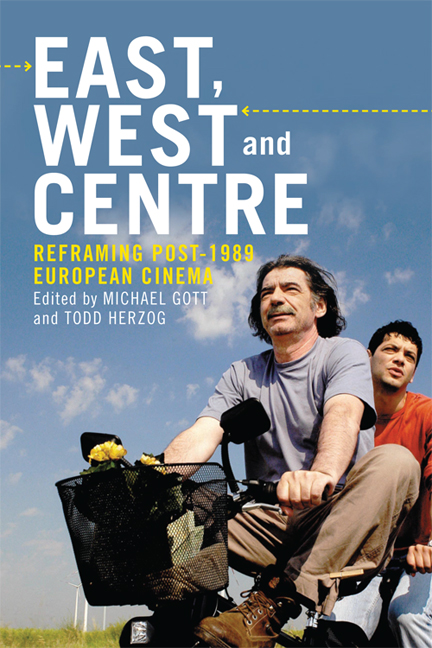Book contents
- Frontmatter
- Contents
- List of Figures
- Notes on Contributors
- Acknowledgements
- Introduction: East, West and Centre: ‘Mapping Post-1989 European Cinema’
- Part I Redrawing the Lines: De/Recentring Europe
- 1 The Berlin Wall Revisited: Reframing Historical Space between East and West in Cynthia Beatts's Cycling the Frame (1988), The Invisible Frame (2009) and Bartosz Konopka's Rabbit à la Berlin (2009)
- 2 Changing Sides: East/West Travesties in Lionel Baier's Comme des voleurs (à l'est)
- 3 Dubbing and Doubling Over: The Disorientation of France in the Films of Michael Haneke and Krzysztof Kieślowski
- 4 Challenging the East–West Divide in Ulrich Seidl's Import Export (2007)
- 5 Fatih Akın's Filmic Visions of a New Europe: Spatial and Aural Constructions of Europe in Im Juli/In July (2000
- 6 Salami Aleikum – The ‘Near East’ Meets the ‘Middle East’ in Europe
- 7 Cinematic Fairy Tales of Female Mobility in Post-Wall Europe: Hanna v. Mona
- Part II Border Spaces, Eastern Margins and Eastern Markets: Belonging and the Road to/from Europe
- Part III Spectres of the East
- Notes
- Bibliography
- Index
1 - The Berlin Wall Revisited: Reframing Historical Space between East and West in Cynthia Beatts's Cycling the Frame (1988), The Invisible Frame (2009) and Bartosz Konopka's Rabbit à la Berlin (2009)
from Part I - Redrawing the Lines: De/Recentring Europe
Published online by Cambridge University Press: 05 September 2016
- Frontmatter
- Contents
- List of Figures
- Notes on Contributors
- Acknowledgements
- Introduction: East, West and Centre: ‘Mapping Post-1989 European Cinema’
- Part I Redrawing the Lines: De/Recentring Europe
- 1 The Berlin Wall Revisited: Reframing Historical Space between East and West in Cynthia Beatts's Cycling the Frame (1988), The Invisible Frame (2009) and Bartosz Konopka's Rabbit à la Berlin (2009)
- 2 Changing Sides: East/West Travesties in Lionel Baier's Comme des voleurs (à l'est)
- 3 Dubbing and Doubling Over: The Disorientation of France in the Films of Michael Haneke and Krzysztof Kieślowski
- 4 Challenging the East–West Divide in Ulrich Seidl's Import Export (2007)
- 5 Fatih Akın's Filmic Visions of a New Europe: Spatial and Aural Constructions of Europe in Im Juli/In July (2000
- 6 Salami Aleikum – The ‘Near East’ Meets the ‘Middle East’ in Europe
- 7 Cinematic Fairy Tales of Female Mobility in Post-Wall Europe: Hanna v. Mona
- Part II Border Spaces, Eastern Margins and Eastern Markets: Belonging and the Road to/from Europe
- Part III Spectres of the East
- Notes
- Bibliography
- Index
Summary
With the fall of the Berlin Wall in 1989 marking the end of the Cold War, twentieth-century history had officially come to an endpoint. When in 2009, however, the twentieth anniversary of this event was marked by (among other things) various filmic contemplations of the walled past, it became clear that history had never ended but, instead, continued to be rewritten through the present. The past was repeatedly rewound, edited and projected, revealing that the Wall's demise had not resulted in a single unified narrative but had brought about various, and often ambivalent, ways of apprehending, rethinking and reframing history through the numerous biographies and memories it encapsulated. This exposed a radical gap in the post-communist experience, an in-between space shifting between East and West, past and future, us and them. Without the Wall to give shape to these trajectories, the past was thus simultaneously opened up and rendered inaccessible; it remains available only, as Hayden White has argued, through the faculty of the imaginary and its mediation (White 1987: 57). In this way Berlin, the historic city of the twentieth century, a modern palimpsest and traumatic Wunderblock, according to Huyssen (1997: 60), does not simply function as a historical text but also serves the setting for an imaginary space through which to (re-)examine its own historical remake through cinematic reconstruction. The Berlin Wall persists at the centre of this text, just as it sat at the centre of the city, ironically decentring the coherent whole of both city and history through an empty space or defining absence at its core. The absolute in-betweenness marked by history's death strip offers a point from which to work through the present-day imaginaries precisely because the aesthetic of absence was crucial to the concrete Wall's operation as a political imposition from the outset. This core absence adhered to an invisible structure of meaning that maintained (and perhaps evoked) the Wall, securing its psychological effectivity. In this context Berliners often speak about a ‘mental’ Wall which has outlived the demise of the actual Wall, leaving an invisible structure that persists and through which the concrete imposition of the past is still maintained. The Wall thus functions as both a projection screen and mirror, an intertextual phenomenon, mediating the past's traumatic imposition and expressing the past as a form of continuous absence.
- Type
- Chapter
- Information
- East, West and CentreReframing post-1989 European Cinema, pp. 23 - 36Publisher: Edinburgh University PressPrint publication year: 2014



